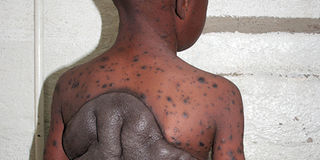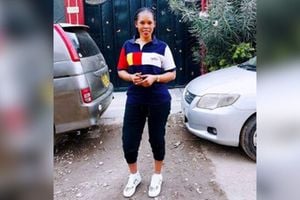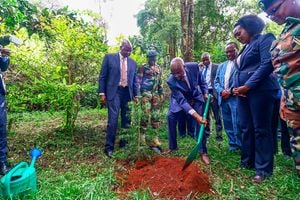Anyone know what this terrible thing is?

Stanley Badia, 8, who has a dark blotch covering the stomach, back and groin area. The growth has now formed folds around the young boy’s waist and back. Photo/MICHAEL MUTE
What you need to know:
- Something horrible is eating Stanley, 8. His mum just wants to know what it is
She first noticed an odd black patch on her baby’s stomach when she held him for the first time.
However, doctors assured Sylvia Atieno that it was a birth mark that would gradually disappear as baby Stanley grew older.
Eight years later, Stanley’s body is a sea of moles and folds of dark skin threatening to cover every part of the body. Ms Atieno noticed that the ‘birth mark’ was growing when Stanley was still a toddler.
She took him to hospital where he was given medicine, but the spots continued to spread to his hands, feet and face.
Formed folds
From a spot, the dark blotch extended to cover the stomach, back and groin area. The growth has now formed folds around the young boys waist and back.
This makes it difficult for him to bend or sit comfortably on a chair.
Ms Atieno’s life has consisted of monthly visits to Kenyatta National Hospital.
“Every time I go to hospital they give me pain killers and advice me to feed him well. Last month the doctors told me that it was a mole disease and that there is no cure,” she said.
Born in 2001, Stanley is the first of three children born to Ms Atieno and her husband who works as a casual worker in Dandora.
Unlike other boys his age, Stanley is quiet and withdrawn.
While his classmates at Dandora Primary School play and run around, Stanley often watches from the sidelines.
“Sometimes I play with my friends but when my body becomes too painful I stop,” murmured the shy boy. He has two friends who he loves to play football with, he said.
In class, Stanley said he cannot sit for long hours because his body becomes sore. During lessons he keeps shifting and standing to ease the pain. The itching causes extra discomfort.
His class teacher, Ms Grace Mbaria, describes him as an average student.
“Sometimes he goes out to play like the other children, but other times he stays back during physical education (PE) lessons,” she said.
Stanley’s mother fears that it may not only be his education that suffers. “He does not sleep well and eats very little,” she says. Since sitting on the sofa can be painful, he spends most of the time on a carpet laid out especially for him.
During one of the visits to hospital when the doctor was explaining that nothing could be done, young Stanley burst into tears. His mother recounts: “He asked me ‘Why is my body different from the other children?’”
“I assure him that one day he will be better but he cried ‘But the doctor said I won’t get better’. I didn’t know what to tell him,” said the sad 24-year-old mother.
It is such frustration that drove her to cross the border in search of a traditional medicine man. Accompanied by her sister, and the little boy, she packed her bags and headed to Tanzania.
“The herbalist was visibly shocked when he saw Stanley,” she narrated. “He did not say what he though it was but gave me some syrup, ointment and soap which I was to wash him with.”
The travelling and medicine cost a fortune for the young and struggling family. The three got stranded in Tanzania and had to ask a friend to send them money for transport back.
For two months she diligently administered the syrup, spread the ointment and bathed her first-born in the herbs as instructed. There was no improvement.
With the doctors and herbalists having failed her, an exasperated Ms Atieno has only one request: “I want to know if there is anyone out there who knows what this disease is.”
She asks for specialists or even people who have the disease to tell her of what treatment to administer to her son.
“All I give him now is painkillers like Brufen, which only stops the pain for a while,” she added.
Her two other children are very healthy so she does not understand what went wrong.
Of her visits to Kenyatta, he says: “I wish they could refer me to someone else instead of always prescribing painkillers.”
Finding help has now become a community effort with the primary school’s headteacher, community health workers and neighbours joining in.
“We are all trying to get help for the child,” said Terry Wayua, the neighbour who alerted Nation to the boy’s plight.
Efforts to reach dermatologists at KNH for comment were futile as one was out for the weekend and the other could be only seen by appointment.
Such a rare case
But a consultant physician, Prof S. Bhatt, who had a look at a photograph of Stanley could not hide his shock.
“I have never seen something like this before,” exclaimed the veteran doctor.
He said in his 30 years of service at the University of Nairobi and the national hospital, he had not come across any case as extensive and rare as Stanley’s.
“If he has been coming to Kenyatta for the past eight years I am surprised no one has made any diagnosis”.
Moles, he said, would have already been surgically removed.
Although he could not give a diagnosis from a photograph and also because that was not his area of speciality, the spots to him indicated a skin disorder, probably cancerous because it keeps growing.
A sample of the tumour would have to be taken for testing at their laboratories.
He offered to forward it to the Dean, School of Health Sciences, as a possible research case.
“The University would be interested to take up such a rare case. They have the facilities and specialists at their disposal,” he said.




